by Chad Nilep
It all started (apparently) in the wee hours of the morning of 29 December 2015 with a doodle by a contributor at Utopian Raspberry – Modern Oasis Machine, a Facebook page specializing in “Memes I guess idk”. The artist wondered, in pictorial form, what ideal dog pants should look like: whether they should cover two legs or four.
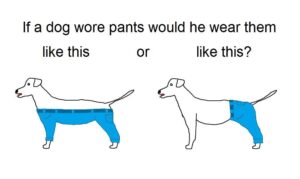
From there, the drawing made its way to Twitter, Reddit, and other social media. Within a day or so it was being discussed in that other kind of media, including Maxim, New York magazine, and The Atlantic. (I would call that a meme, though idk with certainty.)Robinson Meyer, writing at The Atlantic, argued for four-legged dog pants. Meyer reasoned, “Words mean things. […] pants cover all your legs. That’s what pants do. Humans wear two-legged pants because we have two legs. Dogs, on the other hand, have four legs. Ergo, dogs should wear four-legged pants. The left image is correct”.
And here is where the linguists come in. Jonathon Owen of the blog Arrant Pedantry noted in response to Meyer, “Even though it’s clear that words mean things, it’s a lot less clear what words mean and how we know what they mean.” Owen suggested ignoring dog pants temporarily in order to define what pants actually means. He suggested a definition of pants as garments that “cover your body from the waist down”. Based on that definition, “pants cover most or all of the pelvic area plus at least some of the legs.” Thus the four-legged version, which don’t cover the dog’s pelvis, don’t fit the definition. Meyer’s argument fails on its own terms.
Some supercilious commenter suggested that Owen would be better off employing prototype theory to “arrive at an understanding of bad pants and better pants.” Prototype theory, developed by psychologist Eleanor Rosch and employed by cognitive linguists such as Jean Aitchison and George Lakoff, suggests that meaning exists on a gradient. Rather than existing as logical definitions with necessary conditions, word meanings and other concepts are categories that can include prototypical and marginal members. To borrow Aitchison’s example: the category BIRD contains “more ‘birdy’” types such as robins and sparrows, while ostriches and penguins are less birdy but still in the category.
The supercilious commenter (me) undertook a small project by creating 10 images of a person wearing various things (or in one case, nothing at all) below the waist and asking 30 people whether the figure in each image was wearing pants. The results suggest that (contra Robinson Meyer) covering all your legs is neither necessary nor sufficient to a definition of pants. But to reference another meme, I think you’ll find it’s a bit more complicated than that.
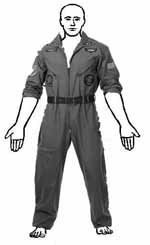
Owen suggested that the four-legged dog pants resemble a backless jumpsuit, and that a jumpsuit is not pants. Most of my respondents agree with him; 19 people said a figure in a jumpsuit is not wearing pants. Nine people, however, said that the figure is wearing pants. (One respondent said “I don’t know,” and one skipped the question.)
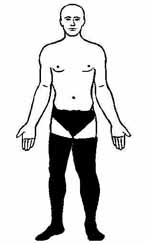 Most of the respondents (23 people) came from the United States. One came from Canada, one from the United Kingdom, and the rest from countries where English is not the majority language. That may help explain why 85% of them said that a figure wearing underpants and stockings was not wearing pants. While the word often refers to underpants in the UK, in other English speaking areas, including the US, it refers to trousers. On the other hand, five people said that a figure wearing a bikini-style swim suit was wearing pants, though 23 (82%) said that he was not.
Most of the respondents (23 people) came from the United States. One came from Canada, one from the United Kingdom, and the rest from countries where English is not the majority language. That may help explain why 85% of them said that a figure wearing underpants and stockings was not wearing pants. While the word often refers to underpants in the UK, in other English speaking areas, including the US, it refers to trousers. On the other hand, five people said that a figure wearing a bikini-style swim suit was wearing pants, though 23 (82%) said that he was not.
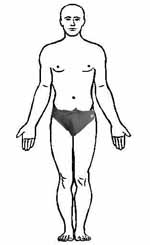 Nearly all respondents said that a nude figure (with genitals blurred but visible) was not wearing pants, though curiously the choice was not unanimous. One respondent said “yes”, the figure is wearing pants. Another illustration showed the figure in stockings with no underwear (genitals again visible). Although no one said this figure was wearing pants, one respondent said, “I don’t know”.
Nearly all respondents said that a nude figure (with genitals blurred but visible) was not wearing pants, though curiously the choice was not unanimous. One respondent said “yes”, the figure is wearing pants. Another illustration showed the figure in stockings with no underwear (genitals again visible). Although no one said this figure was wearing pants, one respondent said, “I don’t know”.
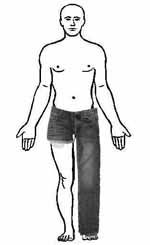 To determine whether pants must cover all legs, the survey included three images of the figure wearing denim jeans. One pair of jeans was intact, covering both legs. One pair had both pant-legs cut off at the hips, and the third pair had one leg cut off and the other intact. Twenty five people (86% of respondents) said that the first figure, with both legs covered, was wearing pants. But the results were mixed for cutoff jeans: slightly fewer than half of respondents (41% for both legs cut; 48% for one leg) said cut jeans were pants, while more than half (59%) said the legless version were not pants. Only 37% said that the one-legged version shown here were not pants; 15% responded, “I don’t know”.
To determine whether pants must cover all legs, the survey included three images of the figure wearing denim jeans. One pair of jeans was intact, covering both legs. One pair had both pant-legs cut off at the hips, and the third pair had one leg cut off and the other intact. Twenty five people (86% of respondents) said that the first figure, with both legs covered, was wearing pants. But the results were mixed for cutoff jeans: slightly fewer than half of respondents (41% for both legs cut; 48% for one leg) said cut jeans were pants, while more than half (59%) said the legless version were not pants. Only 37% said that the one-legged version shown here were not pants; 15% responded, “I don’t know”.
So what have we learned? Well if nothing else we see that academics are just as willing as journalists are to tackle silly subjects during the holidays. But I think there are at least a couple of other conclusions we can make.
Most immediately, the survey suggests that pants don’t necessarily “cover all your legs”. Some things that don’t cover the legs are called pants, while some things that do cover the legs are not. The same is true of covering “the pelvic area plus”; no specific degree of coverage appears to constitute a necessary and sufficient definition of the English word pants.
 More broadly, there doesn’t seem to be any universally shared understanding of what pants refers to. Even the most pantsy images in the collection were not uncontroversial. Three people said that jeans are not pants, and one said that the figure shown here in trousers is not wearing pants.* Of course this is somewhat trivial. Individuals’ understanding of the word’s referent naturally may differ. Why should lexical knowledge be any less controversial than canine haberdashery? Yet it points to a less trivial notion as well.
More broadly, there doesn’t seem to be any universally shared understanding of what pants refers to. Even the most pantsy images in the collection were not uncontroversial. Three people said that jeans are not pants, and one said that the figure shown here in trousers is not wearing pants.* Of course this is somewhat trivial. Individuals’ understanding of the word’s referent naturally may differ. Why should lexical knowledge be any less controversial than canine haberdashery? Yet it points to a less trivial notion as well.
There was not only disagreement across individuals, but uncertainty within an individual’s understanding of the meaning of pants. Four respondents (15%) said “I don’t know” whether a one-legged pair of jeans are pants. At least one respondent each gave that answer for the jumpsuit, jeans, stockings, or a kilt and sporran. Two people didn’t know whether the nude figure was wearing pants.
Linguistic judgements are full of “gray zones” where native speakers lack certainty. This is true for semantic categories, syntactic judgements, phonological forms, social attitudes and ideologies, and a whole host of other areas. Analysts can force those judgements into binary categories, but should perhaps be skeptical of analyses that rely on such force.
*For each of the 10 images, the respondent was asked, “Is the figure wearing pants?” and allowed to select either “Yes”, “No”, or “I don’t know”. It’s therefore possible that the respondents were reacting to something other than the meaning of the word pants. However, the person who said “No” to dress trousers said “Yes” to all three jeans (whole, cutoff, and single-leg), while each of the three who said “No” to jeans said “Yes” to at least one other image.